Products You May Like
I can remember when Perseverance was launched, travelled out into the Solar System and landed on Mars in February 2021.
In all the time since it arrived, having clocked up 1000 days of exploration, it has collected 23 samples from different geological areas within the Jezero Crater. The area was once home to an ancient lake and if there is anywhere on Mars to find evidence of ancient (fossilised) life, it is here.
The date was 30 July 2020 when a gigantic Atlas V-541 rocket roared off the launchpad from Cape Canaveral in Florida. On board was the Perseverance rover, on its way to Mars.
It arrived around 7 months later, entered the Martian atmosphere and successfully landed using a complex sequence of parachutes, retrorockets and for the first time, a sky crane to lower it from a hovering platform.
Its chief purpose on Mars was to explore the geology, climate and atmospheric conditions as a precursor to human exploration.

The landing site, the Jezero Crater, was chosen because previous orbital studies revealed clear evidence of an ancient lake that once filled the crater.
It is thought that water is a key ingredient to the evolution of life so if there had been a body of water, then there is a greater chance of life evolving. Studying the rocks here is like taking a flick through the history books as it preserves signs of ancient life and also ancient environmental conditions.
The crater had been formed, like the majority of other craters in the Solar System from some form of impact event. In the case of Jezero it was an asteroid impact around 4 billion years ago.
On its arrival at the crater the floor was soon discovered to be made of igneous rock, formed from a huge underground chamber of magma and brought to the surface through volcanic activity.
Since then, other types of rock from sand and mud were found providing evidence of the presence of water in Mars’ distant past.

By the time Perseverance had hit the 1000 day anniversary of its exploration of the red planet it had collected the rock samples, safely packaged them up ready for collection and by and large, completed its exploration of the ancient lake bed.
One sample in particular which has been called ‘Lefroy Bay’ has been found to contain fine grained silica. This material is commonly found on Earth and known to preserve fossils.
Another of the samples contains phosphate which, on Earth is most definitely associated with biological processes. Both of these contain carbon which can be used to study the environmental conditions from when the rock formed.
frameborder=”0″ allow=”accelerometer; autoplay; clipboard-write; encrypted-media; gyroscope; picture-in-picture; web-share” referrerpolicy=”strict-origin-when-cross-origin” allowfullscreen>
Jezero crater is a big place, 45 kilometres across so deciding on where to collect the samples was challenging.
When a target site had been identified, Perseverance would first use its abrasion tool to wear away the surface and then use the onboard instruments such as PIXL, the Planetary Instrument for X-ray Lithochemistry.
The instruments on board have the ability to detect both microscopic, fossil-like structures and also to identify chemical changes left behind by ancient microbes.
Alas to date, whilst Perseverance has achieved an amazing amount, the detection of signs of life have eluded the rover.
This article was originally published by Universe Today. Read the original article.
